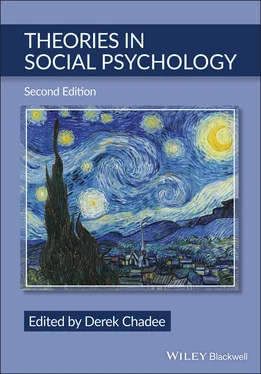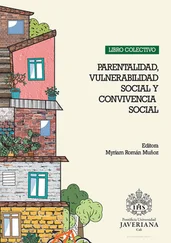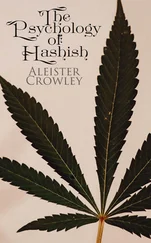Theories in Social Psychology
Здесь есть возможность читать онлайн «Theories in Social Psychology» — ознакомительный отрывок электронной книги совершенно бесплатно, а после прочтения отрывка купить полную версию. В некоторых случаях можно слушать аудио, скачать через торрент в формате fb2 и присутствует краткое содержание. Жанр: unrecognised, на английском языке. Описание произведения, (предисловие) а так же отзывы посетителей доступны на портале библиотеки ЛибКат.
- Название:Theories in Social Psychology
- Автор:
- Жанр:
- Год:неизвестен
- ISBN:нет данных
- Рейтинг книги:5 / 5. Голосов: 1
-
Избранное:Добавить в избранное
- Отзывы:
-
Ваша оценка:
- 100
- 1
- 2
- 3
- 4
- 5
Theories in Social Psychology: краткое содержание, описание и аннотация
Предлагаем к чтению аннотацию, описание, краткое содержание или предисловие (зависит от того, что написал сам автор книги «Theories in Social Psychology»). Если вы не нашли необходимую информацию о книге — напишите в комментариях, мы постараемся отыскать её.
—Robert J. Sternberg,
—Phillip G. Zimbardo, Ph.D., Theories in Social Psychology
Theories in Social Psychology, Second Edition,
Theories in Social Psychology — читать онлайн ознакомительный отрывок
Ниже представлен текст книги, разбитый по страницам. Система сохранения места последней прочитанной страницы, позволяет с удобством читать онлайн бесплатно книгу «Theories in Social Psychology», без необходимости каждый раз заново искать на чём Вы остановились. Поставьте закладку, и сможете в любой момент перейти на страницу, на которой закончили чтение.
Интервал:
Закладка:
Social Influence
Reactance is also a function of pressure to comply (social influence), varying from subtle to outright attempts to achieve compliance. A consequence of social influence is its eroding effect on an individual’s effort to exert influence in a social setting. For example, Brehm and Sensenig (1966) argue that social influence that leads to the usurpation of choice, especially when we are aware of our freedom to make a particular choice, will arouse reactance, resulting in rejection of the source of the social influence. Their study showed that the continuing evaluation of perception of threat was a function of the magnitude of reactance and inclination toward the denunciation of the social influence.
How does reactance or compliant behavior influence regret? Crawford et al. (2002) assess the relationship among reactance, compliance, regret, and persuasive attempts at changing behavior. In assessing anticipated regret, the study found that individuals were more likely to estimate higher regret for any loss if reactant behavior rather than compliance was likely to be displayed to a persuasive attempt. However, in actuality, in an attempt to reduce anticipated regret, individuals were more likely to engage in complying behavior to a request. In fact, individuals displaying anticipated regret and compliant behavior, as against persons displaying reactant behavior, actually experienced higher regret. The authors argue that compliant behavior is associated with dependency, and attribution of blame is externalized, compared to reactance behavior, which involves an independent choice. The reactant person assumes responsibility for their behavioral choice. Another study found that reactance was greater when attempts were made to control or change thoughts and attitudes than behavior, as attempts to control thoughts may have been seen as an initial step toward behavioral control (Ma et al., 2019).
Silvia (2005) assesses the relationship between interpersonal interaction, similarity, and psychological reactance. Similarity between interacting parties reduces resistance and enhances compliance in that similarity increases attraction and liking, which in turn leads to the threatening behavior of liked persons being interpreted as less coercive.
The findings of this study suggest that reactance is more likely to be aroused when a message that is threatening emanates from a dissimilar other. However, when the communicator of a threatening message was similar, persuasion occurred as though the message was not threatening (a normal message). Similarity as a positive interaction factor intervened in influencing compliance and reducing resistance which the threatening message aroused. The findings also suggest that positive social influence can reduce the magnitude of reactance even in a threatening situation. In this study, the researcher created similarity by use of identical first names, dates of birth, and congruent values of communicator-participants.
Resistance can be used to reestablish one’s sense of freedom via a freedom-affirmation intervention. Heilman and Toffler (1976) studied the reaffirming of freedom, assessing the relationship among message (threat or promise), option (no choice or choice option), and interpersonal interaction (interpersonal or non-interpersonal). The research found that compliance was higher in threatening situations when a choice was available, and both threats and promises were equally effective in obtaining compliance in a choice situation.
An important factor in the interpretation of a threatening situation is the degree of interpersonal interaction. Overall, the greater the interpersonal interaction, the greater is the compliance. However, an important finding of the study was the fact that though liking (interpersonal concern) was not the only variable that induced compliance, it moderated responses to freedom reduction (reactance). Other studies have found that compliance increased with high autonomy support message (Ball, 2016) and awareness of freedom to choose (Guéguen, 2016). Reactance research assists in understanding compliance in therapy (Seibel & Dowd, 1999) and adopting coping strategies (Hajek & Veronika, 2021).
Application of Reactance
The application of the theory of psychological reactance has been diverse, from its use in the clinical setting to the understanding of social problems, consumer behavior, and power relationships. Rosenberg and Siegel (2018) categorize the contributions of reactance theory into what they referred to as five overlapping waves. These are: Wave 1: Theory proposal and testing; Wave 2: Contributions from clinical psychology; Wave 3: Contributions from communication research; Wave 4: Measurement of reactance; and Wave 5: Return to motivation. Specifically, the theory of psychological reactance has been applied within psychology and other fields and has provided useful insights in areas such as persuasion and resistance to persuasion, attitude change, pro-social behavior, group attractiveness, family interaction, effects of warning labels, littering, promotional influence, manipulative advertisements, product availability, government regulations as threats to freedom, internet and website interaction, health communication, clinical interaction/counseling and reactant personality, family therapy, political behavior, jury behavior, learned helplessness, dispute resolution, and responses to COVID-19.
Some studies on littering (e.g., Brasted et al., 1979) utilized a reactance theory model to understand the relationship between antilittering advertisements and compliance. Messages that were strongly stated and suggested threats to freedom aroused psychological reactance and attempts to restore freedom. Consumers are influenced by promotional campaigns, but the hard-sell advertisements have less of an impact than the soft-sell (low-threat) ones (Regan & Brehm, 1972).
A multitude of studies was undertaken in the area of reactance, attitude change and persuasion, including Worchel and Brehm’ (1970) study on freedom-threatening communication and attitudinal position; Miller (1976) on persuasive messages and attitude change; Carver (1977) on self-awareness, coercion, and persuasion; and Baer et al. (1980) on self-presentation and public attitudes. Wright and Palmer (2012) note that the use of persuasive techniques on the public to portray specific behavioral patterns elicit reactance tendencies. Reactance that invoke the inoculation effect results in reduced attitude change (Miller et al., 2013). Studies by Bushman (1998, 2006) and Clee and Wicklund (1980) are just a few of the many studies that emphasize the impact of message insensitivity– sensitivity on persuasion and compliance. Reinhart and Anker (2012) utilize reactance and transport theory to understand perceptions of persuasive public service announcements on organ donation (see also Scott & Quick, 2012 ; Sukalla et al., 2017). Baumeister et al. (2002) assess the relationship among narcissism, reactance, and sexual concern, arguing that a man with high sexual expectancy of sexual interaction would experience psychological reactance when there is refusal of sexual contact by a woman. The narcissistic inclination may mediate reactance, motivating the individual to attempt sexual coercion and rape. Family socialization impacts freedom sensitivity, which in turn makes the individual more responsive to freedom threats. In particular, persons with an achievement orientation, high independence, and high moral–religious values were positively associated with psychological reactance (Buboltz et al., 2003).
The application of reactance in understanding virtual interaction on the internet was undertaken by Daily (2004). Restrictions and blocks to navigation on the internet create psychological reactance and lead to negative emotions and avoidance behavior toward the blocked websites. Another study assessed forced exposure via pop-up advertisements and psychological reactance, attempting to understand factors that contribute to negative reactions to information and particularly advertisements via the internet (Edwards et al., 2002).
Читать дальшеИнтервал:
Закладка:
Похожие книги на «Theories in Social Psychology»
Представляем Вашему вниманию похожие книги на «Theories in Social Psychology» списком для выбора. Мы отобрали схожую по названию и смыслу литературу в надежде предоставить читателям больше вариантов отыскать новые, интересные, ещё непрочитанные произведения.
Обсуждение, отзывы о книге «Theories in Social Psychology» и просто собственные мнения читателей. Оставьте ваши комментарии, напишите, что Вы думаете о произведении, его смысле или главных героях. Укажите что конкретно понравилось, а что нет, и почему Вы так считаете.












